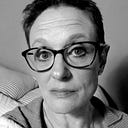Filling Space
When I first moved into my house, boxes weren’t labelled well, so my belongings were strewn about and placed haphazardly throughout the place. I had new rooms, new space, and I got to occupy them. There’s something about empty space that leaves me slightly anxious — I feel the need to fill it. Before I unpacked, I needed to decide the role each room would serve. Some were natural: the kitchen, the bathroom, the pantry. But where would my dining room table go: in the kitchen, or the great room in the front of the house? Which of the four bedrooms was mine? Which bedrooms were my son’s and daughter’s? And the last bedroom — what would that become? I like to fill space — even an empty page yearns to be written on — but the atmosphere of that space matters to me. That last room became a haven for me, a kind of library/office/work room that, no matter what happened anywhere else in the house, that room was inherently and irrefutably mine. When I was being abused, it became both haven and prison to me. I am just now beginning to open it back up again.
Having friends who owned an art gallery, being a collector of things, and being an artist myself, I’ve always had an abundance of options to hang on my walls. I used to be with someone who would haphazardly throw pictures up on the wall, not thinking of the space they were inhabiting or the message the room would give after the frame was hung. This time, this house, I looked at empty walls for months before deciding where my wall hangings would go. The furniture had been placed, the boxes unpacked, the curtains were up — everything in the house was ready save those blank walls that needed to be filled. More empty space. I deliberated. I took my time selecting from my collection — wanting each room to convey to whoever entered the correct ambiance of this house, my house. I still move things around on shelves, but rarely. My space is amply filled. A person may enter and think my collection and trinkets are merely something to glance at, but to me they tell a story. My story.
Perhaps the way I fill my space deliberately and fully has to do with the space in my brain. I have a brain that tends to misfire. Whether it’s from my mental illness, the fact that I was born this way, or from my brain injuries, I don’t know. But my memory isn’t so great. I use written directions at work and lists and informative books to help me remember things. My space at home is also a way of ordering the chaos in my head. There are days when, despite my best efforts at regulating my thoughts, they get scrambled up like a many-colored rubber band ball or a multi-string mass that has been tangled by playing with it too long. On these days, I can’t sort out the space in my head — it’s too full already, and has gotten out of order because of a trigger, stress, lack of sleep, the weather — or maybe the moon. I sometimes can’t predict my bad brain days. But on these days, I can’t sort out the thoughts.
I used to think if you had space, you should fill it. An empty shelf or bookcase needs something on it. A wall shouldn’t be empty. I treated my time and my brain the same way. Until I started having more bad brain days. My full calendar, filled with to-do lists that I thought HAD to have each item crossed off by a certain time, was wearing me thin. My space was filling, becoming cluttered. So was my brain.
I’ve recently learned that some space is good. If I give myself a day off, the rubber band ball doesn’t seem so unconquerable, and I can find an end and start to untangle it. Empty time can become peace through meditation or listening to music. Down time is necessary for renewing, rejuvenation. Space allows for rest, for breath, for regaining the balance in my brain.
And that to-do list that I thought I had to get done tomorrow? Much of it could wait.
Filling space isn’t always the answer. Though I’m delighted to have my own space I can claim and hold on to, I’m also grateful for the space of an empty afternoon.
The view is so much better when you have the space to see it.
8–23–21
Tansy Julie Soaring Eagle Paschold
